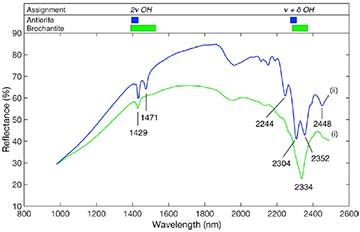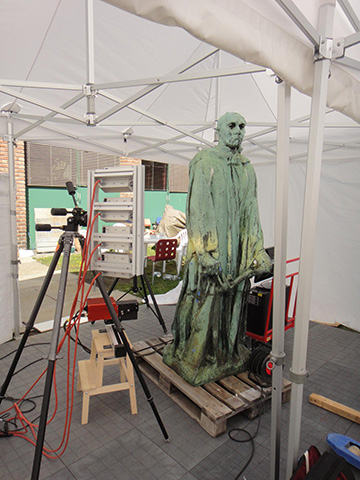The research team used a shortwave-infrared hyperspectral camera (red and black box), a bank of lights for illumination, and computer processing to map corrosion in a cast of Rodin’s The Man with the Key. [Image: City of Oslo Art Collection] [Enlarge image]
For those in the business of preserving bronze statues, much of the job boils down to an obsession with the arcane details of corrosion. Now, conservators aiming to better understand corrosion’s ravages, and thus better protect outdoor statues from the insults of acid rain and deterioration, can draw on a new tool: hyperspectral imaging, or HSI (J. Spectral Imag., doi: 10.1255/jsi.2018.a10).
A team of researchers from Norway, Sweden and Italy used HSI to map corrosion on the surface of a badly degraded bronze cast of The Man with the Key, the first figure in the celebrated Burghers of Calais by Auguste Rodin. The researchers found that the imaging technique could provide high-resolution insight on the distribution of different corrosion products otherwise indistinguishable to the naked eye. That kind of insight, in turn, could aid in developing conservation strategies.
Acid rain, advanced degradation
The Man with the Key in question is a larger-than-life bronze cast of the original Rodin piece. Since 1902, the cast has stood in the Solli plass, a square in Oslo, Norway, noted for its traffic and congestion. This has subjected the statue to acid rain and high levels of sulfur dioxide pollution, putting it, in the scientists’ words, into “a state of advanced degradation.”
For a statue like this urban man of bronze, the most important corrosion products are two copper sulfates, brochantite and antlerite—green, crusty substances impossible to tell apart visually. But while visually indistinguishable, the two sulfates can have a very different implications for preserving a bronze statue’s long-term health. Antlerite, for example, is more water soluable and less protective to the underlying statue than brochantite, which makes antlerite-encrusted regions more vulnerable to rainwater erosion. A single statue can even have “microenvironments” that serve as hot spots of a sort for the growth of certain kinds of corrosion, providing a toehold for accelerated deterioration depending on which sulfate is active.
Getting a big-picture view
The problem has been mapping these different corrosion products across the large area of a statue like The Man with the Key. In general, art conservators studying a statue’s corrosion rely on chemical analysis of microsamples taken from discrete spots on the artwork. That’s fine as far as it goes—but it’s painstaking, invasive and doesn’t provide detailed information on the spatial distribution of the corrosion products over the entire statue.
To see if HSI could overcome these problems, the international team—led by Emilio Catelli and OSA member Lise Lyngsnes Randeberg of the Norwegian University of Science and Technology—covered the Solli plass statue, which had been temporarily moved to the courtyard of Oslo’s Vigeland Museum, with what is described in the paper as a “party tent,” to ensure uniform, diffuse lighting. A bank of LEDs provided additional, controlled artificial illumination.

A test using the hyperspectral camera on reference samples of antlerite and brochantite revealed different spectral features that could be used to distinguish the two corrosion products. [Image: Reproduced with permission, from E. Catelli et al., J. Spectral Imag. 7, a10 (2018); doi: 10.1255/jsi.2018.a10]
Next, the team then set up and trained on the statue a hyperspectral camera from the Norwegian firm Norsk Elektro Optikk that covered the shortwave infrared (SWIR) range, from 960 to 2500 nm. (A previous investigation with reference samples grown in the lab had shown that antlerite and brochantite had different spectral features in that wavelength band.) Completing the setup was a computer to slurp up and crunch the voluminous hyperspectral data using Matlab routines written by the researchers.
Using that setup, the team hyperspectrally scanned the statue in a series of 10×7-cm sample patches, making sure to hit both unsheltered and partially sheltered areas of the statue. The researchers then processed the hyperspectral data and sized the results up against the readings from the reference samples of antlerite and brochantite. They also compared the hyperspectral data from the statue with separate, non-hyperspectral compositional analyses of microsamples taken from some of the same areas covered by the hyperspectral scans.
Data cube
HSI, which has been widely used in food safety, forensic investigations and other applications, returns data in the form of a “data cube” consisting of two spatial dimensions and one wavelength dimension (see “Hyperspectral imaging for safety and security,” OPN, October 2015). The result is that each pixel in the sampled area gets a full spectral readout—covering, in this case, 256 wavelengths at a spectral resolution of 5.7 nm across the hyperspectral camera’s SWIR band. In principle, the spectral profile gleaned at each pixel dot can then be used to infer the likely composition and combination of sulfates in the corrosion at that particular point on the statue.
The researchers found that using these data cubes, and in particular by analyzing the overtones and combination bands in the pixel-by-pixel SWIR spectra, they were able to suss out the spatial distribution of antlerite and brochantite in the statue. What’s more, the nonuniform distribution of these two sulfates—something that could easily escape conventional study approaches based on point sampling—showed up clearly in the hyperspectral data.
The authors believe this is the first time that HSI has been applied in situ to study corrosion on a bronze statue like The Man with the Key—but they don’t think it will be the last. “Being non-destructive and allowing in situ analysis of large corroded areas,” they write, “SWIR HSI can represent an important new tool for the investigation of bronze statuary.”
They add that expanding the technique to allow mapping of other corrosion products, and building better equipment to scan across the complex topography of sculptures, could make HSI even more useful to conservators. That’s good news, it would seem, in the ceaseless battle to protect outdoor art from the ravages of age, urban pollution and deterioration.

